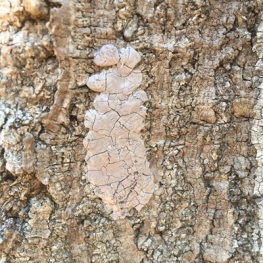
The flying scourge called spotted lanternfly was first found in Pennsylvania in 2014, less than a decade ago. The insect quickly made headlines as it ravaged forests, farms, orchards, and vineyards around the mid-Atlantic states. Now, in a February 2023 post from the Massachusetts Introduced Pest Outreach Project, we learn: "Our spotted lanternfly (SLF) survey crew has already located and destroyed over 5,500 SLF egg masses in infested areas so far this winter!" (Sign up for Massachusetts pest alerts.)
This winter, though, you can do something to limit their spread.
“Examine trees for egg masses,” says Dr. Victoria Smith, state entomologist with the Connecticut Agricultural Experiment Station. (See all the photos and read the complete text of this article at Zip06/TheDay.)
“Look at the trunks of maples, willows, walnuts, and all fruit trees. Spotted lanternflies like trees with sweet sap,” Smith says. “Above all, look at the Tree of Heaven” (Ailanthus altissima).
Ironically, the tree of heaven is the spotted lanternfly’s preferred host tree, though the insect will also lay eggs on maples, willows, and many fruit trees. According to invasive plant experts, tree of heaven is one of our region’s most noxious landscape weeds.
If you find suspicious egg masses in Connecticut, Smith recommends two actions. “First, take a photograph and send it with the location information to reportSLF@ct.gov. “Second, remove the egg mass by scraping. You can use a putty knife, and old butter knife, an expired credit card, an ice scraper or anything that will remove the egg mass,” she says. “Be careful to not dig into the bark of trees you want to keep.”
The egg masses appear in two forms, one like a slurry of putty on the trunk. The other form lacks the “putty” covering, and the individual eggs are exposed as scales. Visit the CAES website: portal.ct.gov/CAES/CAPS/CAPS/Spotted-Lanternfly---SLF.
Peter Picone, a wildlife biologist with the Connecticut Department of Energy and Environmental Protection, has removed large tree of heaven infestations on conservation land. He suggests that you can identify tree of heaven’s presence any time of year, including winter. “The bark is different from most other trees, resembling a cantaloupe,” he says. “And if you break a twig, you may get a bad peanut butter or kerosene scent.”
There’s another winter clue. Tree of Heaven has both male and female trees. In winter, many female trees are visible because they hold seed clusters at the ends of branches. (See all the photos and read the complete text of this article at Zip06/TheDay.)
“You can return to cut and remove tree of heaven any time of year,” says Picone. “But be prepared to monitor stump sprouts beginning in spring and new sprouts that appear independent of the original trunk.” The tree overtakes areas by sending underground runners as much as 100 feet from the main trunk.
The most reliable removal method is to strip bark on the lower trunk. Many people are chagrined to learn that the next steps inevitably include herbicides.
“We don’t have a reliable non-herbicidal method for this killing this plant,” says Picone. Landowners can employ a licensed pesticide operator or use one of the protocols described on the Connecticut Invasive Plant Working Group site: cipwg.uconn.edu/tree-of-heaven/.
Picone concludes, “By controlling invasive Tree of Heaven, you’ll also help control invasive spotted lanternfly. That can be very rewarding.”
See all the photos and read the complete text of this article at Zip06/TheDay.
